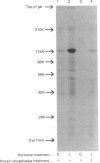Abstract
The activation of acetyl-CoA carboxylase (measured in a crude supernatant fraction) caused by insulin treatment of adipocytes was completely unaffected by the addition of a large amount of highly purified protein phosphatase to the supernatant fraction. Under the same conditions the inhibition of acetyl-CoA carboxylase by adrenaline was totally reversed. Experiments with 32P-labelled adipocytes showed that insulin increased the total phosphorylation of acetyl-CoA carboxylase from 2.7 to 3.5 molecules of phosphate/240 kDa subunit, and confirmed that this increase was partially accounted for by phosphorylation within a specific peptide (the 'I-site' peptide). Protein phosphatase treatment of the crude supernatant fractions removed over 80% of the 32P radioactivity from the enzyme and removed all detectable radioactivity from the I-site peptide. The effect of insulin on acetyl-CoA carboxylase activity, but not the effect on phosphorylation, was lost on purification of the enzyme on avidin-Sepharose. The effect on enzyme activity was also lost if crude supernatant fractions were subjected to rapid gel filtration after treatment under conditions of high ionic strength, similar to those used in the avidin-Sepharose procedure. These results show that, although insulin does increase the phosphorylation of acetyl-CoA carboxylase at a specific site, this does not cause enzyme activation. They suggest instead that activation of the enzyme by insulin is mediated by a tightly bound low-Mr effector which dissociates from the enzyme at high ionic strength.
Full text
PDF


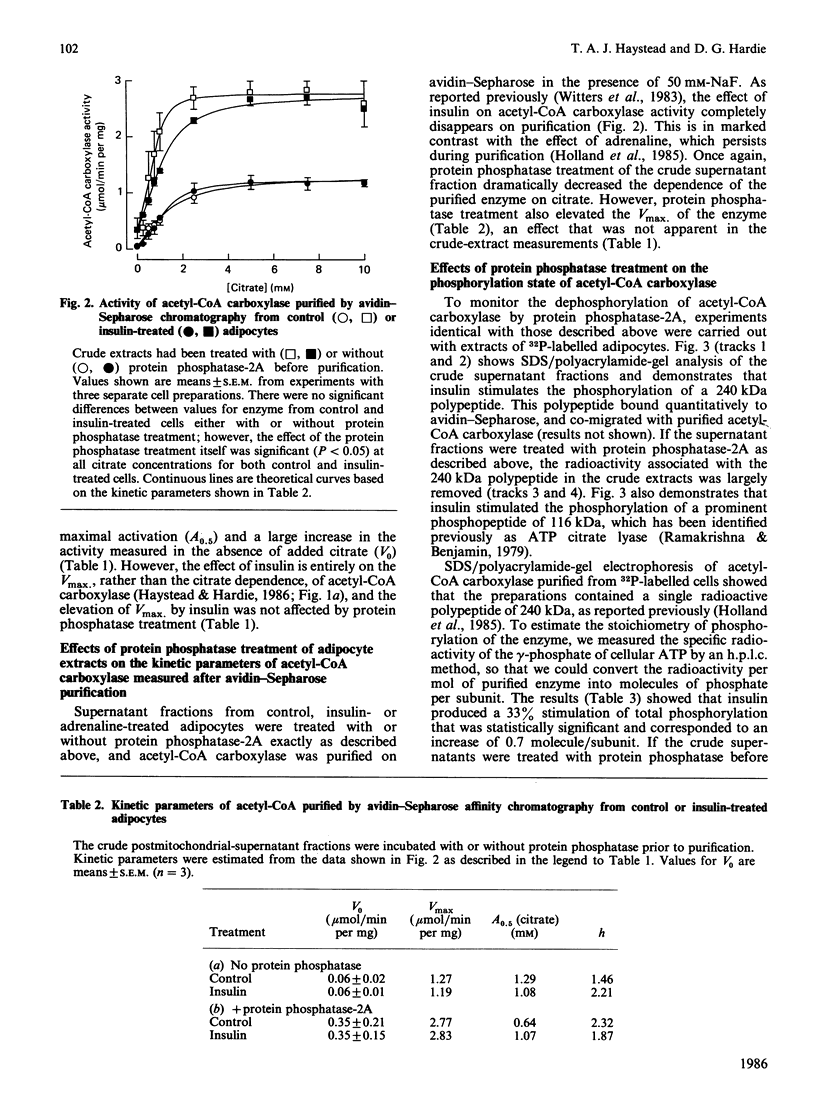
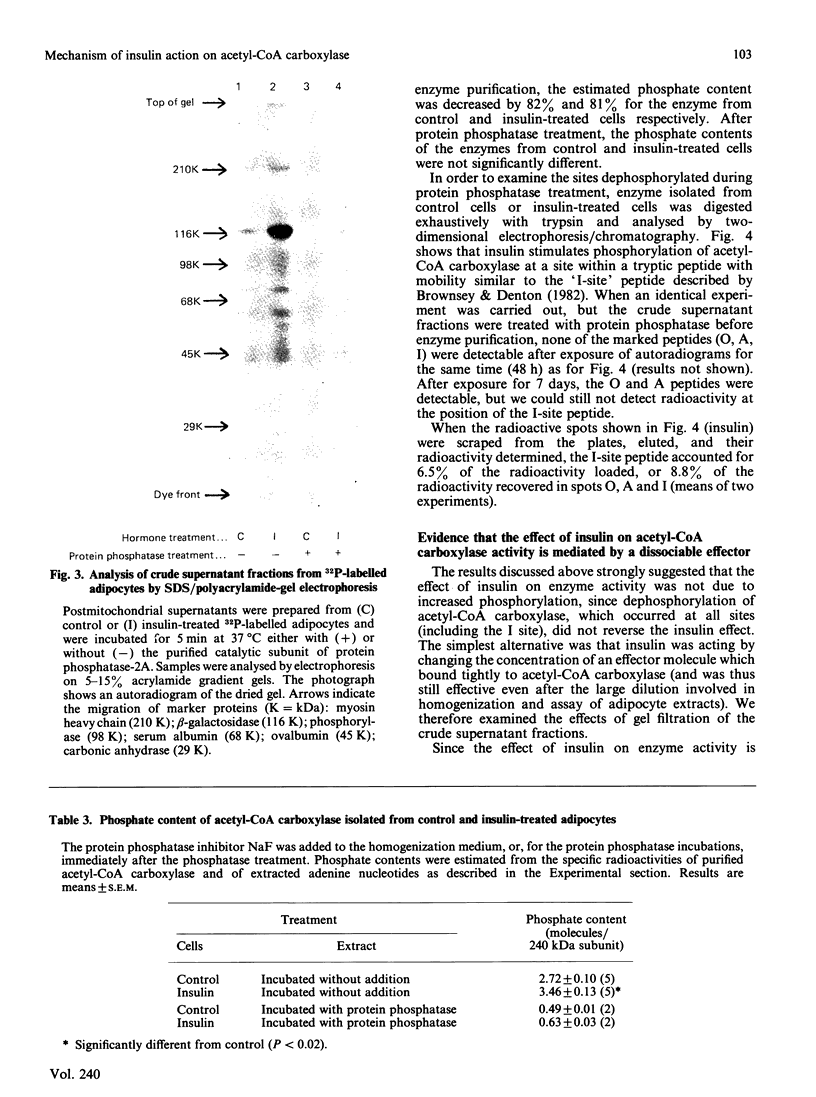
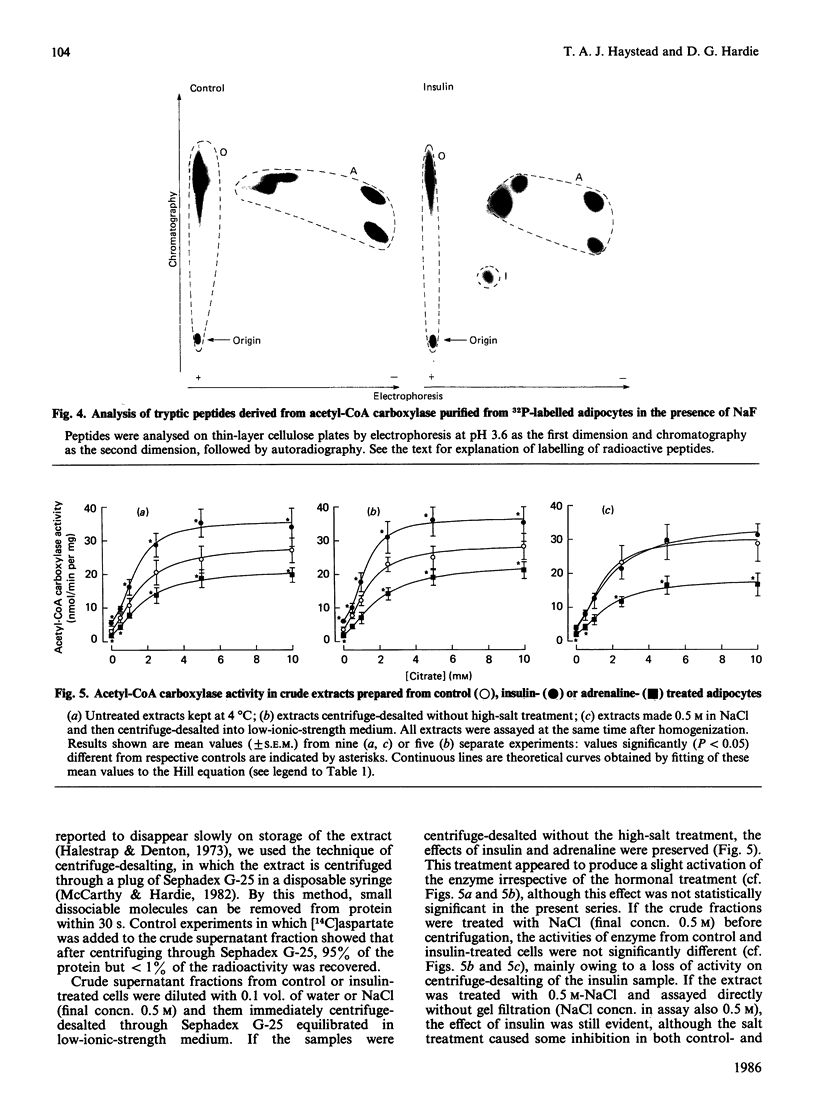
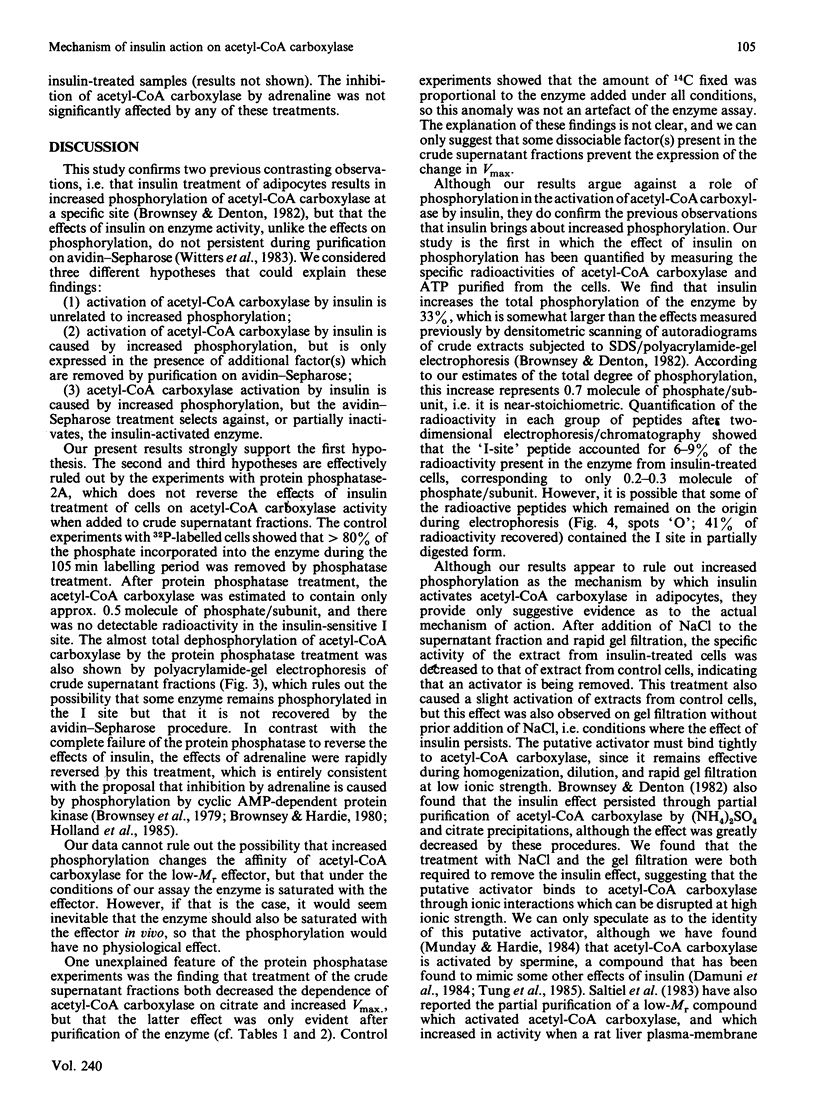
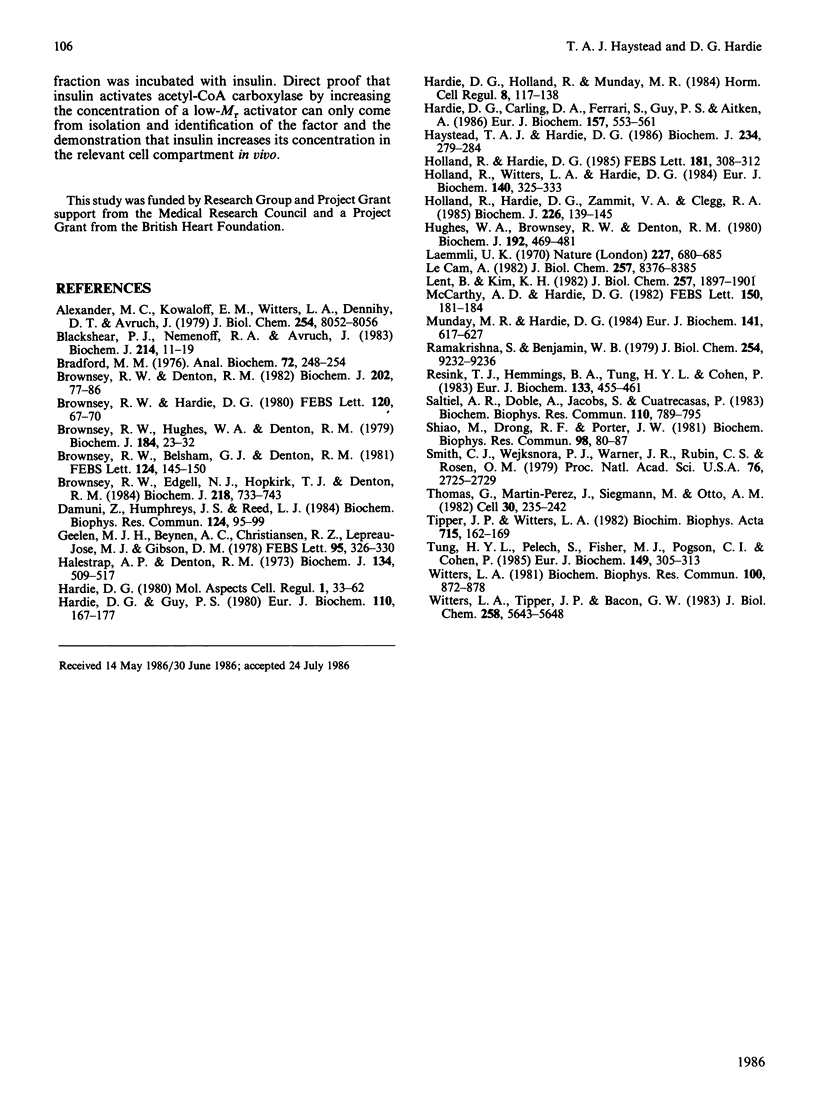
Images in this article
Selected References
These references are in PubMed. This may not be the complete list of references from this article.
- Alexander M. C., Kowaloff E. M., Witters L. A., Dennihy D. T., Avruch J. Purification of a hepatic 123,000-dalton hormone-stimulated 32P-peptide and its identification as ATP-citrate lyase. J Biol Chem. 1979 Aug 25;254(16):8052–8056. [PubMed] [Google Scholar]
- Blackshear P. J., Nemenoff R. A., Avruch J. Insulin and growth factors stimulate the phosphorylation of a Mr-22000 protein in 3T3-L1 adipocytes. Biochem J. 1983 Jul 15;214(1):11–19. doi: 10.1042/bj2140011. [DOI] [PMC free article] [PubMed] [Google Scholar]
- Bradford M. M. A rapid and sensitive method for the quantitation of microgram quantities of protein utilizing the principle of protein-dye binding. Anal Biochem. 1976 May 7;72:248–254. doi: 10.1006/abio.1976.9999. [DOI] [PubMed] [Google Scholar]
- Brownsey R. W., Belsham G. J., Denton R. M. Evidence for phosphorylation and activation of acetyl CoA carboxylase by a membrane-associated cyclic AMP-independent protein kinase. Relationship to the activation of acetyl CoA carboxylase by insulin. FEBS Lett. 1981 Feb 23;124(2):145–150. doi: 10.1016/0014-5793(81)80123-8. [DOI] [PubMed] [Google Scholar]
- Brownsey R. W., Denton R. M. Evidence that insulin activates fat-cell acetyl-CoA carboxylase by increased phosphorylation at a specific site. Biochem J. 1982 Jan 15;202(1):77–86. doi: 10.1042/bj2020077. [DOI] [PMC free article] [PubMed] [Google Scholar]
- Brownsey R. W., Edgell N. J., Hopkirk T. J., Denton R. M. Studies on insulin-stimulated phosphorylation of acetyl-CoA carboxylase, ATP citrate lyase and other proteins in rat epididymal adipose tissue. Evidence for activation of a cyclic AMP-independent protein kinase. Biochem J. 1984 Mar 15;218(3):733–743. doi: 10.1042/bj2180733. [DOI] [PMC free article] [PubMed] [Google Scholar]
- Brownsey R. W., Hardie D. G. Regulation of acetyl-CoA carboxylase: identity fo sites phosphorylated in intact cells treated with adrenaline and in vitro by cyclic AMP-dependent protein kinase. FEBS Lett. 1980 Oct 20;120(1):67–70. doi: 10.1016/0014-5793(80)81048-9. [DOI] [PubMed] [Google Scholar]
- Brownsey R. W., Hughes W. A., Denton R. M. Adrenaline and the regulation of acetyl-coenzyme A carboxylase in rat epididymal adipose tissue. Inactivation of the enzyme is associated with phosphorylation and can be reversed on dephosphorylation. Biochem J. 1979 Oct 15;184(1):23–32. doi: 10.1042/bj1840023. [DOI] [PMC free article] [PubMed] [Google Scholar]
- Damuni Z., Humphreys J. S., Reed L. J. Stimulation of pyruvate dehydrogenase phosphatase activity by polyamines. Biochem Biophys Res Commun. 1984 Oct 15;124(1):95–99. doi: 10.1016/0006-291x(84)90921-5. [DOI] [PubMed] [Google Scholar]
- Geelen M. J., Beynen A. C., Christiansen R. Z., Lepreau-Jose M. J., Gibson D. M. Short-term effects of insulin and glucagon on lipid synthesis in isolated rat hepatocytes. Covariance of acetyl-CoA carboxylase activity and the rate of 3H2O incorporation into fatty acids. FEBS Lett. 1978 Nov 15;95(2):326–330. doi: 10.1016/0014-5793(78)81022-9. [DOI] [PubMed] [Google Scholar]
- Halestrap A. P., Denton R. M. Insulin and the regulation of adipose tissue acetyl-coenzyme A carboxylase. Biochem J. 1973 Mar;132(3):509–517. doi: 10.1042/bj1320509. [DOI] [PMC free article] [PubMed] [Google Scholar]
- Hardie D. G., Carling D., Ferrari S., Guy P. S., Aitken A. Characterization of the phosphorylation of rat mammary ATP-citrate lyase and acetyl-CoA carboxylase by Ca2+ and calmodulin-dependent multiprotein kinase and Ca2+ and phospholipid-dependent protein kinase. Eur J Biochem. 1986 Jun 16;157(3):553–561. doi: 10.1111/j.1432-1033.1986.tb09702.x. [DOI] [PubMed] [Google Scholar]
- Hardie D. G., Guy P. S. Reversible phosphorylation and inactivation of acetyl-CoA carboxylase from lactating rat mammary gland by cyclic AMP-dependent protein kinase. Eur J Biochem. 1980 Sep;110(1):167–177. doi: 10.1111/j.1432-1033.1980.tb04852.x. [DOI] [PubMed] [Google Scholar]
- Haystead T. A., Hardie D. G. Both insulin and epidermal growth factor stimulate lipogenesis and acetyl-CoA carboxylase activity in isolated adipocytes. Importance of homogenization procedure in avoiding artefacts in acetyl-CoA carboxylase assay. Biochem J. 1986 Mar 1;234(2):279–284. doi: 10.1042/bj2340279. [DOI] [PMC free article] [PubMed] [Google Scholar]
- Holland R., Hardie D. G. Both insulin and epidermal growth factor stimulate fatty acid synthesis and increase phosphorylation of acetyl-CoA carboxylase and ATP-citrate lyase in isolated hepatocytes. FEBS Lett. 1985 Feb 25;181(2):308–312. doi: 10.1016/0014-5793(85)80282-9. [DOI] [PubMed] [Google Scholar]
- Holland R., Hardie D. G., Clegg R. A., Zammit V. A. Evidence that glucagon-mediated inhibition of acetyl-CoA carboxylase in isolated adipocytes involves increased phosphorylation of the enzyme by cyclic AMP-dependent protein kinase. Biochem J. 1985 Feb 15;226(1):139–145. doi: 10.1042/bj2260139. [DOI] [PMC free article] [PubMed] [Google Scholar]
- Holland R., Witters L. A., Hardie D. G. Glucagon inhibits fatty acid synthesis in isolated hepatocytes via phosphorylation of acetyl-CoA carboxylase by cyclic-AMP-dependent protein kinase. Eur J Biochem. 1984 Apr 16;140(2):325–333. doi: 10.1111/j.1432-1033.1984.tb08105.x. [DOI] [PubMed] [Google Scholar]
- Hughes W. A., Brownsey R. W., Denton R. M. Studies on the incorporation of [32P]phosphate into pyruvate dehydrogenase in intact rat fat-cells. Effects of insulin. Biochem J. 1980 Nov 15;192(2):469–481. doi: 10.1042/bj1920469. [DOI] [PMC free article] [PubMed] [Google Scholar]
- Laemmli U. K. Cleavage of structural proteins during the assembly of the head of bacteriophage T4. Nature. 1970 Aug 15;227(5259):680–685. doi: 10.1038/227680a0. [DOI] [PubMed] [Google Scholar]
- Le Cam A. Insulin and glucagon regulation of protein phosphorylation in isolated hepatocytes. Persistence, reversibility, and concentration dependence of hormonal effect. Evidence for common phosphorylation sites for both hormones on the Mr = 46,000 protein. J Biol Chem. 1982 Jul 25;257(14):8376–8389. [PubMed] [Google Scholar]
- Lent B., Kim K. H. Purification and properties of a kinase which phosphorylates and inactivates acetyl-CoA carboxylase. J Biol Chem. 1982 Feb 25;257(4):1897–1901. [PubMed] [Google Scholar]
- McCarthy A. D., Hardie D. G. Evidence that the acyl-O-esters are intermediates in the catalysis. The mechanism of rabbit mammary fatty acid synthase. FEBS Lett. 1982 Dec 13;150(1):181–184. doi: 10.1016/0014-5793(82)81330-6. [DOI] [PubMed] [Google Scholar]
- Munday M. R., Hardie D. G. Isolation of three cyclic-AMP-independent acetyl-CoA carboxylase kinases from lactating rat mammary gland and characterization of their effects on enzyme activity. Eur J Biochem. 1984 Jun 15;141(3):617–627. doi: 10.1111/j.1432-1033.1984.tb08237.x. [DOI] [PubMed] [Google Scholar]
- Ramakrishna S., Benjamin W. B. Fat cell protein phosphorylation. Identification of phosphoprotein-2 as ATP-citrate lyase. J Biol Chem. 1979 Sep 25;254(18):9232–9236. [PubMed] [Google Scholar]
- Resink T. J., Hemmings B. A., Tung H. Y., Cohen P. Characterisation of a reconstituted Mg-ATP-dependent protein phosphatase. Eur J Biochem. 1983 Jun 15;133(2):455–461. doi: 10.1111/j.1432-1033.1983.tb07485.x. [DOI] [PubMed] [Google Scholar]
- Saltiel A. R., Doble A., Jacobs S., Cuatrecasas P. Putative mediators of insulin action regulate hepatic acetyl CoA carboxylase activity. Biochem Biophys Res Commun. 1983 Feb 10;110(3):789–795. doi: 10.1016/0006-291x(83)91031-8. [DOI] [PubMed] [Google Scholar]
- Shiao M. S., Drong R. F., Porter J. W. The purification and properties of a protein kinase and the partial purification of a phosphoprotein phosphatase that inactivate and activate acetyl-CoA carboxylase. Biochem Biophys Res Commun. 1981 Jan 15;98(1):80–87. doi: 10.1016/0006-291x(81)91872-6. [DOI] [PubMed] [Google Scholar]
- Smith C. J., Wejksnora P. J., Warner J. R., Rubin C. S., Rosen O. M. Insulin-stimulated protein phosphorylation in 3T3-L1 preadipocytes. Proc Natl Acad Sci U S A. 1979 Jun;76(6):2725–2729. doi: 10.1073/pnas.76.6.2725. [DOI] [PMC free article] [PubMed] [Google Scholar]
- Thomas G., Martin-Pérez J., Siegmann M., Otto A. M. The effect of serum, EGF, PGF2 alpha and insulin on S6 phosphorylation and the initiation of protein and DNA synthesis. Cell. 1982 Aug;30(1):235–242. doi: 10.1016/0092-8674(82)90029-0. [DOI] [PubMed] [Google Scholar]
- Tipper J. P., Witters L. A. In vitro phosphorylation and inactivation of rat liver acetyl-CoA carboxylase purified by avidin affinity chromatography. Biochim Biophys Acta. 1982 Apr 13;715(2):162–169. doi: 10.1016/0304-4165(82)90354-3. [DOI] [PubMed] [Google Scholar]
- Tung H. Y., Pelech S., Fisher M. J., Pogson C. I., Cohen P. The protein phosphatases involved in cellular regulation. Influence of polyamines on the activities of protein phosphatase-1 and protein phosphatase-2A. Eur J Biochem. 1985 Jun 3;149(2):305–313. doi: 10.1111/j.1432-1033.1985.tb08927.x. [DOI] [PubMed] [Google Scholar]
- Witters L. A. Insulin stimulates the phosphorylation of acetyl-CoA carboxylase. Biochem Biophys Res Commun. 1981 May 29;100(2):872–878. doi: 10.1016/s0006-291x(81)80254-9. [DOI] [PubMed] [Google Scholar]
- Witters L. A., Tipper J. P., Bacon G. W. Stimulation of site-specific phosphorylation of acetyl coenzyme A carboxylase by insulin and epinephrine. J Biol Chem. 1983 May 10;258(9):5643–5648. [PubMed] [Google Scholar]



